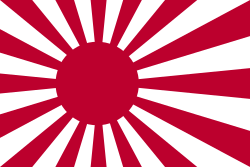| Special Naval Landing Force (SNLF) 海軍陸戦隊 Kaigun-rikusen-tai | |
|---|---|
 The ensign of the Imperial Japanese Navy Land Forces | |
| Active | 1929–1945 |
| Country | Empire of Japan |
| Allegiance | Empire of Japan |
| Type | Marine Corps |
| Engagements | Sino-Japanese War, Soviet-Japanese border conflicts, World War I, World War II |
Imperial Japanese Navy Land Forces of World War II originated with the Special Naval Landing Forces, and eventually consisted of the following:
- The Naval Landing Force or 海軍陸戦隊 Kaigun-rikusen-tai: In the narrow sense, a temporal unit consists sailors for ground battles. In the wide sense, a general term means Navy Land Force.
- Japanese Special Naval Landing Forces or 海軍特別陸戦隊 Kaigun-tokubetsu-rikusen-tai: the Japanese Marines
- The Base Force or 根拠地隊 Konkyo-chitai and The Special Base Force or 特別根拠地隊 Tokubetsu-konkyo-chitai provided services, primarily security, to naval facilities
- Defence Units or 防備隊 Bōbi-tai or 防衞班 Bōei-han: detachments of 200 to 400 men.
- Guard Forces or 警備隊 Keibi-tai: detachments of 200–500 men who provide security to Imperial Japanese Navy facilities
- Air Defence Units or 防空隊 Bōkū-tai: Antiaircraft artillery units of 200-300 men equipped with 8 Anti-Aircraft guns or 24 AA machine guns.
- Pioneers or Construction Units or 海軍設営隊 Kaigun-setsuei-tai built naval facilities, including airstrips, on remote islands. Most of personnel were civilian employees and unarmed.
- The Naval Communications Units or 通信隊 Tsūshin-tai of 600–1,000 men to provide basic naval communications. They also handled encryption and decryption.
- The Tokkeitai Navy military police units were part of the naval intelligence armed branch, with military police regular functions in naval installations and occupied territories; they also worked with the Imperial Japanese Army's Kempeitai military police, the Keishi-chō civil police and Tokkō secret units in security and intelligence services.
Although both the Keibi-tai and Bōbi-tai received amphibious assault and beach defence training, their performance was poor or average when they were used as assault troops.
References[]
- Kenkyusha's New Japanese-English Dictionary, Kenkyusha Limited, Tokyo 1991, ISBN 4-7674-2015-6
See also[]
- Imperial Japanese Navy bases and facilities
- 海上機動旅団(Sea Landing Brigades) - Japanese Wikipedia article [Not translated]
- Japanese seaplane carrier Nisshin
- Type D submarine
- Type 4 Ka-Tsu
The original article can be found at Imperial Japanese Navy Land Forces and the edit history here.